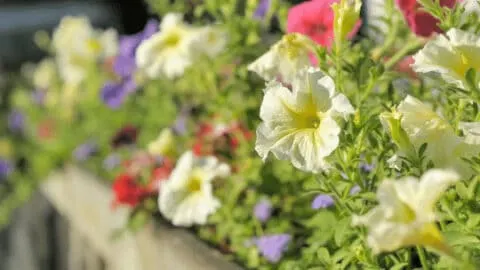If you are planning a garden for your yard, it is almost inevitable that there will be petunias in it.
Pretty, versatile in color, and easy to care for, these pretty little flowers are delightful to look at in any setting, garden, or container.
They are annual plants, and while that means that you have to plant new ones every year, you still want them to look amazing for the year.
Although easy to care for, one of the most common problems with them is their foliage turning yellow.
Table of Contents
Why are my petunias turning yellow?
Petunias usually turn yellow for one of the following reasons: Nutrient deficiency, improper watering, inadequate sunlight or heat, and viral or fungal diseases. In some cases, pests such as aphids can be the reason for the yellowing leaves on your petunias.
Nutrient Deficiency in Petunias
Petunias are a heavy-blooming plant and as such, need to be fertilized and fed regularly.
Some of the more common reasons for a nutrient deficiency with petunias are that the roots are too compacted to get adequate nutrients and water to the plant or that they are not being fertilized often enough or with the right fertilizer.
When you plant petunias, it is a good idea to shake the roots loose before you plant them to ensure that they are not all bunched together.
Sometimes, they will be twisted tightly together.
In this case, you will need a sterilized set of shears to gently clip and untwist them before planting them.
If they are bunched together, the plant will not be able to feed itself properly, and consequently, the leaves will turn yellow, and the plant could die.
How often do I have to fertilize petunias?
Petunias need to be fertilized with a balanced fertilizer every 2 to 3 weeks. I start fertilizing mine in early July and continue until the growing season is complete. Container grown petunias will do well with a time-release fertilizer but spreading ones can need to be fertilized more often.
Can petunias be over-fertilized?
Yes, they can. Unfortunately, the symptoms of over-fertilizing are the same as with under-fertilizing. The leaves turn yellow and wilt.
If the issue is a fertilizer with too much nitrogen, petunias will not only turn yellow but won’t flower.
If you suspect you have over-fertilized, stop using the fertilizer immediately and don’t use it again until the plants are healthy.
Water the petunias deeply, soaking the soil down to the first 2 or 3 inches.
If they are container plants, water them liberally until water comes pouring out of the drainage holes. This will flush some of the fertilizer out and help the plant to recover.
Improper Watering
Petunias need a fair bit of water. However, they do not like their leaves or petals to sit in water. The soil should be moist but not wet all the time.
It is best to use a soaker hose before the sun comes up on them to prevent the water from burning the plant in the sun and to prevent the plant itself from getting wet.
If a soaker hose isn’t an option, water close to the soil, being careful not to get water on the leaves and flowers.
Inadequate Sunlight or Heat
Petunias need bright sunlight and warm weather to grow at their best. If there is not enough sun or the weather is too cool, they could turn yellow and wilt.
Yellowing Petunias — Diseases
Fungal diseases are one type of disease that can cause petunias to turn yellow and ultimately die. Petunias can get fungal infections from overwatering, which can cause root and stem rot. Verticillium wilt is another type of fungal infection that causes petunias to yellow.
If you have a few plants with a fungal disease, you have to remove them from the rest of the plants. Otherwise, it will spread to all the other plants and ultimately kill them all. Make sure you dig out all of the roots of the diseased plants when you remove them.
Sometimes, humidity or overcrowding can be the cause of fungal diseases.
Always ensure there is room between your plants for air to circulate.
The other type of disease that can affect petunias is viral disease.
The most common one is Tobacco Mosaic Virus.
Tobacco is bad for humans, but it is also bad for some plants. It is spread through aphids and contaminated soil but also from a smoker’s hands.
This virus causes the leaves to turn a mottled yellow and deforms the leaves and the flowers. If you are a smoker, scrub your hands before working in the garden.
Pests
Aphids can spread Tobacco Mosaic Virus from plant to plant but can also wreak havoc by feeding on the plant. They will turn the leaves yellow and cause their growth to be stunted.
The best way to treat an aphid infestation is a mix of water and insecticidal soap.
Spray it on when the sun is not on the plants and the temperature is below 90 degrees Fahrenheit.
Conclusion
Petunias are a pretty and easy-to-manage addition to any garden or container garden. They come in various colors to match pretty much any color scheme.
The biggest issue with caring for them is yellowing leaves.
However, by adhering to the guidelines presented, you can effectively mitigate this issue and maintain a bright, vibrant garden throughout the season.

Daniel has been a plant enthusiast for over 20 years. He owns hundreds of houseplants and prepares for the chili growing seasons yearly with great anticipation. His favorite plants are plant species in the Araceae family, such as Monstera, Philodendron, and Anthurium. He also loves gardening and is growing hot peppers, tomatoes, and many more vegetables.


